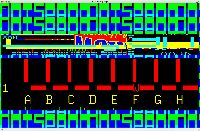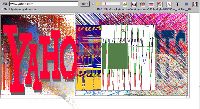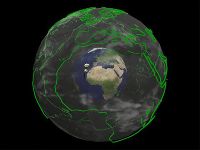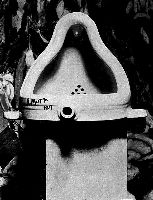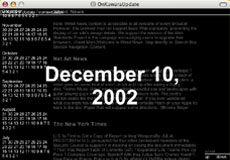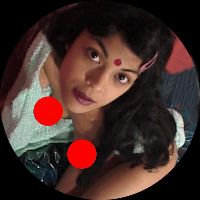New Media Art – Introduction – Mark Tribe
New Media Art – Introduction – Mark Tribe – Brown University Wiki
Defining New Media art
In 1993, at the start of the “dot com” boom, two European artists, Joan Heemskerk and Dirk Paesmans, paid a visit to California’s Silicon Valley. When they returned home, they created jodi.org, a Web-site-as-art-work whose scrambled green text and flashing images seem to deconstruct the visual language of the Web. Heemskerk and Paesmans remixed found images and HTML scripts much as Dada artists played with the photographic imagery and typography of magazines and newspapers. Jodi.org changed the way many people think about the Internet, demonstrating that it didn’t just provide a new way to publish information; it could also be an art medium like oil painting, photography, or video. Like other works of New Media art, jodi.org exploited an emerging technology for artistic purposes.
1994 was a watershed year in the linked histories of media technology and digital culture. The Netscape Corporation introduced the first commercial Web browser, signaling the Internet’s transformation from a computer network used primarily by computer enthusiasts and academic researchers into a popular medium for personal communication, publishing, and commerce. Terms like “the Net,” “the Web,” “cyberspace,” and “dot com” soon became part of the international vernacular, and a major societal shift appeared to be underway?from industrial production to information economies, from hierarchical organizations to distributed networks, from local markets to global ones. The Internet meant different things to different people: to entrepreneurs, it was a way to get rich quick; to activists, it was a means of building grassroots support for political causes; to media magnates, it represented a new channel for distributing content. This last group used the term “new media” to describe digital publishing forms like CD-ROMs and the Web. To “old media” companies, these nascent technologies indicated a move away from traditional outlets, such as newspapers and television, to emerging forms of interactive multimedia. In 1994, major media companies — including the Hearst Corporation, which owned numerous American periodicals and television networks?formed “new media” divisions, and trade groups such as the New York New Media Association were first organized. Around the same time, artists, curators, and critics started to use the term “New Media art” to refer to works?such as interactive multimedia installations, virtual reality environments, and Web-based art?that were made using digital technology.
New Media art and older categorical names like “Digital art,” “Computer art,” “Multimedia art,” and “Interactive art” are often used interchangeably, but for the purposes of this book we use the term New Media art to describe projects that make use of emerging media technologies and are concerned with the cultural, political, and aesthetic possibilities of these tools. We locate New Media art as a subset of two broader categories: Art and Technology and Media art. Art and Technology refers to practices, such as Electronic art, Robotic art, and Genomic art, that involve technologies which are new but not necessarily media-related. Media art includes Video art, Transmission art, and Experimental Film — art forms that incorporate media technologies which by the 1990s were no longer new. New Media art is thus the intersection of these two domains. We chose to limit the scope of this book to work that was made after the term New Media art was broadly adopted in 1994, and to focus on works that are particularly influential, that exemplify an important domain of New Media art practice, and that display an exceptional degree of conceptual sophistication, technological innovation, or social relevance.
Deciding what counts as media technology is a difficult task. The Internet, which is central to many New Media art projects, is itself composed of a heterogeneous and constantly changing assortment of computer hardware and software?servers, routers, personal computers, database applications, scripts, and files?all governed by arcane protocols, such as HTTP, TCP/IP, and DNS. Other technologies that play a significant role in New Media art include video and computer games, surveillance cameras, wireless phones, hand-held computers, and Global Positioning System (GPS) devices. But New Media art is not defined by the technologies discussed here; on the contrary, by deploying these technologies for critical or experimental purposes, New Media artists redefine them as art media. In the hands of Radical Software Group (RSG), for example, data surveillance software, similar to that used by the United States’ Federal Bureau of Investigation (FBI), becomes a tool for artistic data visualization. In addition to exploring the creative possibilities of this software, RSG develops a critique of surveillance technology and its uses.
Art historical antecedents
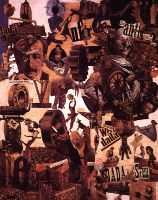
Hannah Hoch, Schnitt mit dem Kiichenmesser Dada durch die letzte Weimarer Bierbauchkulturepoche, 1920
Although New Media art is, on one level, all about the new — new cultural forms, new technologies, new twists on familiar political issues — it did not arise in an art historical vacuum. The conceptual and aesthetic roots of New Media art extend back to the second decade of the twentieth century, when the Dada movement emerged in several European cities. Dada artists in Zürich, Berlin, Cologne, Paris, and New York were disturbed by what they perceived as the self-destructive bourgeois hubris that led to the First World War, and began to experiment with radically new artistic practices and ideas, many of which resurfaced in various forms and references throughout the twentieth century. Much as Dada was in part a reaction to the industrialization of warfare and the mechanical reproduction of texts and images, New Media art can be seen as a response to the information technology revolution and the digitization of cultural forms.
Many Dadaist strategies reappear in New Media art, including photomontage, collage, the readymade, political action, and performance — as well as Dada artists’ provocative use of irony and absurdity to jar complacent audiences. Fragmented juxtapositions of borrowed images and texts in works like Shu Lea Cheang’s Brandon and Diane Ludin’s Genetic Response System 3.0 (2001) are reminiscent of the collages of Raoul Hausmann, Hannah Höch, and Francis Picabia.
Marcel Duchamp’s readymades prefigured countless New Media art works involving blank appropriation, from Alexei Shulgin’s WWWArt Award to RSG’s Prepared PlayStation (2005). The work of George Grosz, John Heartfield, and other Berlin Dadaists who blurred the boundaries between art and political action serve as important precedents for activist New Media art projects like Electronic Disturbance Theater’s FloodNet and Fran Illich’s Borderhack. The performances of Emmy Hennings, Richard Huelsenbeck, and others at the Cabaret Voltaire in Zürich set the stage for New Media performance artists such as Alexei Shulgin and Cary Peppermint. And echoes of Hugo Ball’s absurdist sound poems can be heard in r a d i o q u a l i a’s Free Radio Linux.
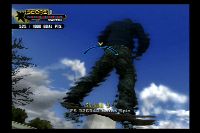
RSG, Prepared PlayStation, 2005
Pop art is another important antecedent. Like Pop paintings and sculptures, many works of New Media art refer to and are engaged with commercial culture. Much as Pop artist Roy Lichtenstein reproduced comic book images in his paintings, the New Media artist duo Thompson and Craighead sampled a video game (Space Invaders) in Trigger Happy (1998). Lichtenstein’s meticulous emulation of the Benday dots used in comic books and other contemporary print media anticipates the work of artists like eBoy, who painstakingly construct images pixel by pixel. By reproducing images from comic books, advertisements, and magazines in “high art” media like oil paint on canvas, Pop artists ultimately distanced themselves from the popular culture that inspired them. In contrast, New Media artists tend to work with the very media from which they borrow (e.g. games) rather than transposing them into forms that fit more neatly within art world conventions.
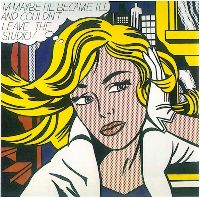
Roy Lichtenstein, M-Maybe, 1965
Whereas Pop art was strongly invested in the craft of making paintings and sculptures, Conceptual art, also a significant precursor to New Media art, focused more on ideas than on objects. New Media art is often conceptual in nature. John F. Simon Jr.’s Every Icon, for example, includes a Java applet (a small program that runs in a Web browser) that is programmed to run through, over the course of many trillions of years, every possible image that can be formed within a 32 x 32 grid. Much as Lawrence Weiner’s “Indefinite Material Descriptions” (e.g. One Quart Exterior Industrial Enamel Thrown on a Brick Wall, 1964) don’t need to be realized to exist as art works, Simon’s Every Icon doesn’t need to be seen (or completed) to be understood.
New Media art has strong parallels to Video art as well. The emergence of Video art as a movement was precipitated by the introduction in the late 1960s of the portable video camera, or PortaPak. Previously, Video art had been practiced by a few pioneers (most notably Nam Jun Paik). The availability of relatively inexpensive video equipment caught the attention of artists like Joan Jonas, Vito Acconci, William Wegman, Bill Viola, and Bruce Nauman. A generation later, the introduction of the Web browser catalyzed the birth of New Media art as a movement. New Media artists saw the Internet much as their predecessors saw the portable video camera: as an accessible artistic tool that enabled them to explore the changing relationship between technology and culture.
New Media art as a movement
While the art of the 1970s was defined by distinct movements (e.g., Conceptual art, Feminist art, Land art, Media art, Performance art), the 1980s gave rise to an overheated art market and a plethora of micro-movements. Many of these, such as Neo-Expressionism and Neo-Conceptualism, were postmodern recuperations of previous moments in art history. After the art market crash that followed “Black Monday” (October 19, 1987, the day the United States’ stock markets collapsed), these micro-movements lost their momentum and, by the early 1990s, had largely run their course, leaving a conspicuous void (although trends, such as identity politics and large-scale photography, could be identified). Fed by the growth of Masters of Fine Arts programs and supported by the expansion of museums, contemporary art continued to thrive, but artistic practices did not cohere into definable movements. Painting was declared dead by critics, collectors, and artists alike, as video and installation came to dominate international museum and biennial exhibitions. It was against this background of extreme fragmentation that New Media art emerged at end of the twentieth century.
From 1994 until 1997, when Net art was first included in the Documenta X exhibition in Kassel, Germany, New Media art existed in relative isolation from the rest of the art world. E-mail lists and Web sites served as alternative channels for the discussion, promotion, and exhibition of New Media art work, enabling artists to form an online art scene that straddled the worlds of contemporary art and digital culture.
Because of its close connection to the Internet, however, New Media art was from its inception a worldwide movement. The Internet facilitated the formation of communities without regard for geography. The international nature of the New Media art movement reflected the increasingly global nature of the art world as a whole, as evidenced by the proliferation in the 1990s of international biennial exhibitions, including the Johannesburg Biennial and the Gwangju Biennial.
This shift was part of a much larger historical trend: the globalization of cultures and economies. Globalization was both a cause and an effect of the widespread use of the Internet, wireless telephones, and other information and communication technologies. The emergence of a “global village” of the sort that Marshall McLuhan predicted in his 1962 book The Gutenberg Galaxy created unprecedented demand for these technologies, driving their rapid development and deployment. They also enabled globalization by facilitating international trade, multinational partnerships, and the free exchange of ideas. New Media art reflected these developments and explored their effects on society, much as video art served as a lens through which to understand television and its role in an increasingly media-centric culture.
Advances in personal computing hardware and software also played a significant role in the emergence of New Media art as a movement in the 1990s. Although personal computers had been on the market for more than a decade (the popular Apple Macintosh was introduced in 1984), it wasn’t until the mid-1990s that affordable personal computers were powerful enough to manipulate images, render 3D models, design Web pages, edit video, and mix audio with ease. Equally important, the first generation of artists to have grown up with personal computers and video games (in the 1980s) was coming of age. These young artists were as comfortable with new media as they were with more traditional cultural forms.
Beginnings
Marcel Duchamp, Fountain, 1917/1964
For all these reasons — the emergence of a global art scene, advances in information technology, and the familiarity of computing to a rising generation — artists were drawn to New Media art from other disciplines. Previously, computer-based art had been a marginal field practiced primarily by a small cadre of dedicated pioneers. The confluence of factors outlined above, along with a general sense of excitement and fascination with the potential of new technologies, created an unprecedented level of interest in new media on the part of painters, performance artists, activist artists, filmmakers, conceptual artists, etc. Whether fueled by dot-com era enthusiasm or critical of what media theorist Richard Barbrook called the “California Ideology” (a heady cocktail of libertarianism and technological utopianism exemplified by the editorial voice of Wired magazine), artists around the world started to work with emerging media technologies in ways that were informed by the conceptual and formal qualities of their former disciplines. The painter Mark Napier, for example, who worked by day as a database software programmer for Wall Street financial firms, demonstrated his compositional sensibilities and his interest in color in such early Internet-based works as Shredder 1.0.
For many artists, the advent of the Internet meant that computers were no longer merely tools for manipulating images, designing invitations to gallery shows, and writing grant applications. Suddenly, computers became a gateway to an international community of artists, critics, curators, collectors, and other art enthusiasts. Although some artists used the Internet as a way of disseminating documentation of work made in other media (e.g. by putting a portfolio of scanned photographs on the Web), others approached the Internet as a medium in its own right or as a new kind of space in which to intervene artistically.
In 1995, a Slovenian artist named Vuk Cosic encountered the phrase “net.art” in a garbled e-mail message. Although the period, or “dot,” was eventually dropped, the term “Net art” quickly caught on among artists and others in the nascent New Media art scene and became the preferred label for Internet-based artistic practices. It was not a coincidence that the term originated in Eastern Europe; many important artists in the early history of Net art were located there, like Alexei Shulgin, and Olia Lialina, both based in Moscow . After the fall of the Iron Curtain and the collapse of Soviet Union, artists in that region had a unique perspective on the Internet’s dot-com era transformation — they were living in societies making the transition from Socialism to Capitalism, a phenomenon that in many ways mirrored the privatization of the Internet.

Allan Kaprow, 18 Happenings in 6 Parts, 1959
Compared to other forms of New Media art, Net art was relatively inexpensive to produce, and therefore more accessible to artists with limited financial means. Many of the core technologies, such as the Apache Web server and Hypertext Markup Language (HTML), were available for free. All an artist needed to make Net art, besides ideas and technical skills, was a computer (even an old one would do), a modem, and an Internet connection. Although such connections were expensive for those who lived in countries where local telephone charges were high, many New Media artists found ways to access the Internet for free through public libraries, universities, and corporations. For many New Media artists, day jobs as programmers or Web site designers provided access to the tools of production (computer hardware and software), speedy Internet connections, and in some cases, valuable training.
Because it dovetailed with the rise of the Internet and concomitant cultural and economic shifts, Net art played a key role in the New Media art movement, but it was by no means the only type of New Media art practice. Other significant genres include Software art, Game art, New Media installation, and New Media performance, although individual projects often blur the boundaries between these categories. Many works of Game art, for example, use Web-based technologies and are meant to be experienced online. Natalie Bookchin’s The Intruder is simultaneously a work of Game art and a work of Net art, as is Velvet Strike by Anne-Marie Schleiner, Brody Condon, and Joan Leandre.
Themes/tendencies
Collaboration and participation
New Media artists often work collaboratively, whether in ad-hoc groups or in long-term partnerships. Like films or theatrical productions, many New Media art projects — particularly the more complex and ambitious ones — require a range of technological and artistic skills to produce. The development of Radical Software Group’s Carnivore for example, involved the participation of several programmers, and numerous artists and artist groups have been invited to contribute to the project by building interfaces. Sometimes, however, the motivation to collaborate is more ideological than practical. By working in collectives, New Media artists challenge the romantic notion of the artist as a solitary genius. Eleven of the thirty-five artists and groups discussed in the main section of this book identify themselves collectively. This is the case with ®TMark, an artist group whose members used assumed names and a corporate identity as part of an elaborate critique of the special protections corporations receive under United States law. Other New Media art groups that work under a shared name include the Bureau of Inverse Technology, Fakeshop, Institute for Applied Autonomy, Mongrel, and VNS Matrix.
The New Media art movement continued an art historical shift from passive audience reception to active participation that was previously exemplified by the Happenings of the 1960s and 1970s. In Alan Kaprow’s seminal 18 Happenings in 6 Parts (1959), for example, audience members were directed to specific seats in various rooms of the exhibition venue, where they followed strictly choreographed movements at particular times.
Many New Media art works, such as Jonah Brucker-Cohen and Katherine Moriwacki’s UMBRELLA.net and Golan Levin et. al’s Dialtones: A Telesymphony, involve audience participation. Other works of New Media art require audience members to interact with the work but not to participate in its production. In interactive New Media art, the work responds to audience input but is not altered by it. Audience members may click on a screen to navigate through a web of linked pages, or activate motion sensors that trigger computer programs, but their actions leave no trace on the work itself. Each member of the audience experiences the piece differently based on the choices he or she makes as while interacting with the work. In Olia Lialina’s My Boyfriend Came Back from the War, for example, visitors click through a series of frames on a Web page to reveal images and fragments of text. Although the elements of the story never change, the way the story unfolds is determined by each visitor’s own actions.
From appropriation to open source
Artists have always influenced and imitated one another, but in the twentieth century various forms of appropriation, from collage to sampling, emerged as an alternative to ex nihilo creativity. Enabled by technologies of mechanical reproduction, artists began to use found images and sounds in their work. Hannah Höch’s Dadaist photomontages, Marcel Duchamp’s readymades, Andy Warhol’s Pop art Brillo Boxes, Bruce Connor’s Found Footage films, and Sherrie Levine’s Neo-conceptual remakes all reflected the changing status of artistic originality in the face of mass-produced culture.
In New Media art, appropriation has become so common that it is almost taken for granted. New media technologies such as the Web and file-sharing networks gave artists easy access to found images, sounds, texts, and other media. This hyperabundance of source material, combined with the ubiquitous “copy” and “paste” features of computer software, further eroded the notion that creating something from scratch is better than borrowing it. In After Sherrie Levine (2001), New Media artist Michael Mandiberg takes appropriation to an almost absurd extreme. In 1979, Sherrie Levine re-photographed Walker Evans’s classic Depression-era photographs of an Alabama sharecropper family. Mandiberg scanned images from a catalogue featuring Levine’s photographs of Evans’s work, and posted them on the Web at AfterSherrieLevine.com. As part of an “explicit strategy to create a physical object with cultural value, but little or no economic value,” Mandiberg invited visitors to print the images along with certificates of authenticity and specific framing instructions.
As appropriation became an increasingly important artistic strategy, the intellectual property laws and policies that govern access to found material grew ever more restrictive. In the 1990s and 2000s, movie studios, the recording industry, and other corporate content owners became more and more concerned about the unauthorized copying and distribution of their assets. They lobbied successfully to extend copyright terms and to make it illegal to circumvent copyright protection measures (e.g., the encryption schemes that accompany DVDs). These corporations also moved aggressively to police copyright violations, for example by pursuing legal action against individuals who illegally shared music online. The resulting tension between artistic practices and the intellectual property regime led New Media artists, musicians, and other cultural practitioners to look for alternative models for authoring and sharing their work. They found a model in open source software, an approach to developing computer applications in which a program’s source code is made freely available to a distributed network of programmers who develop features and fix problems. Like New Media art, open source software involves collaboration, relies on the Internet, and depends on a gift economy in which altruism and “ego boo,” or the peer-recognition that motivates programmers and artists alike, are the primary motivators. New Media artists who adopt open source principles tend to appropriate found material, to collaborate with other artists, and to make their own work available to others on a share-and-share-alike basis. Examples of this approach include Cory Arcangel’s Super Mario Clouds, Radical Software Groups (RSG)’s Carnivore, Raqs Media Collective’s OPUS, 0100101110101101.ORG’s Life Sharing, and r a d i o q u a l i a’s Free Radio Linux.
While rooted both in Duchamp’s assisted readymades and Pop art’s recycling of everything from advertisements to comic books, New Media art remixes are also influenced by the sampling and remixing practices of popular music, particularly hip-hop and electronic dance music. These genres involve not only the borrowing and recombining of musical fragments, but also the production of new versions of familiar songs through the addition of new elements and the rearrangement of existing ones. Like popular hip-hop tracks, certain works of New Media art, such as Olia Lialina’s My Boyfriend Came Back From the War, have been remixed again and again. Some New Media artists even go so far as remix their own work. In BUST D0WN THE D00R AGAIN! GATES 0F HELL-VICT0RIA VERSI0N, Young Hae Chang Heavy Industries replaces the original work’s background, alters the text color, changes the soundtrack, and adds a Korean translation.
The interdisciplinary convergence of popular music and New Media art is explored in various ways by Paul Miller aka Dj Spooky That Subliminal Kid, an influential DJ, writer, and artist. Miller exemplifies the remix sensibility in Rebirth of a Nation (2002), a series of live performances in which he reworks D.W. Griffith’s controversial 1915 film Birth of A Nation while assembling an improvised soundtrack out of layers of sampled sound.
Early New Media artists were sometimes criticized for their lack of art historical knowledge and for overlooking their work’s relationship to such precedents as Dada, Pop art, and Media art. But many New Media artists consciously reflect art history in their work, reinterpreting or updating projects from the 1960s and 1970s in the context of a new technological environment. MTAA’s OnKawaraUpdate (2001), for example, uses a software program to mimic the concept and aesthetic of Conceptual artist On Kawara’s date paintings. InEmpire 24/7, Wolfgang Staehle uses a live Web camera projection to remake Andy Warhol’s Empire, an eight-hour-long film of the Empire State Building. John F. Simon, Jr. revisits Paul Klee’s experimental use of the Cartesian grid in Every Icon. And Jennifer and Kevin McCoy use databases to reinterpret films in such projects as 201: A Space Algorithm, their version of Stanley Kubrick’s 2001: A Space Odyssey (1968). Along with a penchant for collaboration and a marked tendency to appropriate rather than to create from scratch, this media-archeological approach to art-making exemplifies the attenuation of authorial originality in New Media art.
A fascination with the past also manifests itself in the work of New Media artists who mine or mimic obsolete digital media technologies. Cory Arcangel’s Super Mario Clouds is a nostalgic take on the video game Super Mario Brothers. Natalie Bookchin’s The Intruder, and Keith and Mendi Obadike’s The Pink of Stealth also pay homage to early video games. In 386 DX, Alexei Shulgin uses an outdated personal computer to perform covers of classic pop songs. This aesthetic of obsolescence and crudeness, sometimes known as “dirt style,” stands in contrast to the clean lines and slickness of much New Media art and design.
Corporate parody
The Web enabled Amazon.com, a startup bookseller, to grow into a retail giant, and it empowered bloggers to compete with major news organizations as a source for information and opinion. The Web also made it easy for New Media artists to produce online presences that convincingly mimicked the aesthetics and rhetoric of corporate sites, complete with logos, brand names, and slogans. In Airworld (1999), for example, Jennifer and Kevin McCoy created an ersatz corporation, complete with a logo, Web site, and uniforms. They built a software bot that crawled the Web looking for corporate marketing jargon, and used the text it found as fodder for an audio Web cast and a low-power radio transmission. The artists also sampled corporate surveillance camera feeds, and persuaded an online advertising company to donate thousands of ad banner impressions to promote the site and the Airworld brand.
Multi-disciplinary artist Miltos Manetas hired Lexicon Branding, the firm that invented such brand names as “PowerBook” and “Pentium,” to coin a term for a “new type of theory, art, architecture, music, and life style, influenced by computers.” Of the several terms Lexicon suggested, Manetas chose “Neen,” announcing his selection at a press conference at the Gagosian Gallery in New York. The art group ®TMark developed Web sites and organized performative actions and pranks that critiqued corporate culture by emulating it.
Hackers and hacktivism
In mainstream newspapers, Hollywood films, and other popular media, hackers are usually portrayed as computer whiz kids who breaks into others’ computers to steal information or simply to wreak havoc. But this notion is only partially correct. Within hacker circles, such attacks are known as cracking, and are frequently frowned upon. According to computer scientist Brian Harvey, a hacker is “someone who lives and breathes computers, who knows all about computers, who can get a computer to do anything. Equally important… is the hacker’s attitude. Computer programming must be a hobby, something done for fun, not out of a sense of duty or for the money… A hacker is an aesthete.” In Harvey’s view, a hacker is actually more like an artist than a criminal. Although some hackers use their skills maliciously, in the hacking community there is a widely recognized moral code, the “hacker ethic,” which holds that the sharing of information is an overriding good, and that hackers should contribute to the advancement of their field by writing open source software and enabling access to knowledge and computer resources.
In his 2004 book A Hacker Manifesto, McKenzie Wark extends the notion of hacking to other domains, including the realm of art, and likens it to innovation. He writes, “Whatever code we hack, be it programming language, poetic language, math or music, curves or colourings, we create the possibility of new things entering the world…. In art, in science, in philosophy and culture, in any production of knowledge where data can be gathered, where information can be extracted from it, and where in that information new possibilities for the world are produced, there are hackers hacking the new out of the old.” Many New Media artists see themselves as hackers, or use hacking as concept or content in their work. These include Cory Arcangel, Knowbotic Research, and Critical Art Ensemble, whose projectChild as Audience (2001) included a CD-ROM with instructions on how to hack into and alter GameBoy video games.
The latter two groups exemplify the activist approach of many hacker artists. This blend of hacking and political activism is often called “hacktivism.” Artist and theorist Cornelia Sollfrank has written about hacking as a metaphor for cultural production, and cultural production as a form of hacking. For her Cyberfeminist project Female Extension, Sollfrank worked with hackers to develop a software program that generates works of Net art by sampling and remixing elements from existing Web sites. To expose the sexism that she believes pervades contemporary curatorial practices, she then submitted more than 200 of these works to an international Net art competition under false female names, thus ensuring that a majority of the entrants were women. When the jury announced the three winners, all of whom were men, Sollfrank revealed her intervention.
The advent of the Internet has made it feasible for artists and others to organize international grassroots movements and to engage in electronic civil disobedience actions. In Zapatista Tactical FloodNet, Electronic Disturbance Theater initiated a symbolic “denial of service attack,” or the disabling of a Web site by overwhelming its server with traffic, against various corporate and institutional Web sites including Chase Manhattan Bank and the office of former Mexican President Ernesto Zedillo. This action was intended as a peaceful act of protest against the Mexican government’s unfair treatment of indigenous Mexicans.
Interventions
For many New Media artists, the Internet is not only a medium but also a an arena in which to intervene artistically?an accessible public space similar to an urban sidewalk or square where people converse, do business, or just wander around. Part of the appeal of this space is that it is outside the museum-gallery complex, and thus gives artists access to a broad, non-art audience. In Velvet Strike, for example, Anne Marie Schleiner, Joan Leandre, and Brody Condon staged interventions within Counter Strike, a popular networked computer game in which players engage in urban battle. Velvet Strike‘s audience includes both members of the international New Media art community and the players of Counter Strike, many of whom resented the intervention, which involved manipulating onscreen characters to act in nonviolent ways rather than engage in conflict.
Many artists have intervened in eBay, the massive online auction site, by offering unusual things for sale. In 2000, Michael Daines, then a 16-year-old high-school student in Calgary, attempted to sell his body under eBay’s sculpture category. By treating his body as a sculptural object, this project recalls the work of Eleanor Antin, Chris Burden, Gilbert and George, and other Performance artists who used their bodies as a medium in their work. The following year, also on eBay, Keith Obadike put his African-American racial identity up for auction in Blackness for Sale (2001), echoing the slave auctions of previous centuries. In the description field on his eBay auction page, Obadike included a list of benefits and warnings that were by turns humorous (e.g. “This Blackness may be used for gaining access to exclusive, ‘high risk’ neighborhoods”) and trenchant (e.g., “The Seller does not recommend that this Blackness be used while making intellectual claims”). The hacktivist art group ®TMark (p.) also used eBay to auction off their individual tickets to an exclusive party connected with the 2000 Whitney Biennial exhibition, both to raise funds for future projects and to make the point that, in the art world, money can buy access.
Other New Media artists intervene in physical public spaces. In Pedestrian, Paul Kaiser and Shelley Eshkar project computer-generated animations onto urban sidewalks and public plazas. In BorderXing, Heath Bunting and Kayle Brandon document their attempts to cross international borders illegally by posting digital photographs and diaristic texts on a Web site. Torolab’s Vertex Project is a proposal for a foot bridge across the Tijuana/San Diego border. Equipped with billboard-sized screens, the bridge would serve as a public gallery for images, texts, and other media submitted via a nearby computer.
Identity
Many New Media artists have used the Internet as a tool to explore the construction and perception of identity. The Internet makes it easy for an artist to create a fictive online persona merely by setting up a free e-mail account or home page. Race, gender, age, sexual orientation, and nationality can all be invented, undermining the notion that art works are authentic expressions of their makers’ identities. Mouchette.org, a Net art project that claims to be the work of a thirteen-year-old girl named Mouchette (after the protagonist of 1967 film by Robert Bresson about an adolescent girl), demonstrates the pliability and uncertainty of online identity. As visitors explore the site, it becomes clear that Mouchette is a fictional invention. Yet the character’s presence, the sense that there really is a girl named Mouchette behind the project, remains convincing. As of this writing, the true identity of the artist responsible for Mouchette has yet to be revealed.
Other New Media artists address issues of identity in more straightforward ways. Shu Lea Cheang’s Brandon, for example, explores the true story of Teena Brandon, a young woman who was murdered for passing as a man. In Bindigirl (1999), Prema Murthy represents herself as an Indian pinup girl in a critique of the Internet pornography industry and the Orientalism found in Asian pornography. The artist group Mongrel has explored issues of identity, particularly race, in several projects, including Uncomfortable Proximity, (2000). In this work, Harwood, one of the group’s members, altered images on the Web site of Tate Britain, one of England’s leading art museums. Harwood combined portraits by British painters, including Thomas Gainsborough, William Hogarth, and Joshua Reynolds, with images of Harwood’s friends and family to create his own version of art history and, through the process, conjure an alternative vision of British identity.
Telepresence and surveillance
The Internet and other network technologies both bridge and collapse geographical distances. This is particularly evident in the use of devices such as Web cams and remote-controlled robots that produce the effect of telepresence, or experience at a distance. Ken Goldberg’s Telegarden, for example, enables people from around the world to tend to the flowers and plants of a garden by controlling a robotic arm via online commands. Similarly, Rafael Lozano-Hemmer’s Vectorial Elevation allows Web site visitors to maneuver robotic spotlights from afar, creating patterns in the sky above public plazas. Other artists working with the concept of telepresence do so in more localized situations. In Eduardo Kac’s Rara Avis (1996), for example, a robotic parrot with a camera behind its eyes is placed inside an aviary along with real birds. Gallery visitors control the parrot’s movements via remote controls, experiencing an avian point of view on a small screen fitted within a headset.
Since the mid-twentieth century, surveillance has been an increasingly significant subject of literature, cinema, and art. From George Orwell’s novel “1984,” first published in 1949, to Francis Ford Coppola’s 1974 film “The Conversation,” surveillance typically has been portrayed as a menacing specter of government or corporate power. By the end of the twentieth century, however, cultural attitudes toward surveillance had become more ambivalent. While concerns about the invasion of privacy remained, surveillance was also seen as a necessary evil, protecting the innocent from threats of abuse, crime, or terrorism. Surveillance began to appear not only as a technology of military and police control but also as a form of entertainment. In Web sites like JenniCAM, in which a young woman installed Web cameras in her home to expose her everyday actions to online viewers, and Reality television shows like “Big Brother,” in which contestants volunteered to subject themselves to around-the-clock public observation, surveillance became a source of voyeuristic and exhibitionistic excitement. This shift paralleled a dramatic rise in the sophistication and pervasiveness of such surveillance technologies as networked cameras, biometric identification systems, satellite imaging, and data mining.
Institutional surveillance and the invasion of privacy have been widely explored by New Media artists. Ken Goldberg’s Demonstrate, for example, uses a telerobotic video camera and an interactive Web site to allow people to observe activity at the University of California at Berkeley’s Sproul Plaza, a birthplace of the Free Speech movement in the 1960s. Marie Sester’s ACCESS (2003) casts a beam of light on those who pass beneath its electronic eye. Sester uses image recognition technology to identify individual figures, singling them out in crowds and tracking them as they move about. An acoustic beam system directs whispered voices that only the tracked subject can hear. ACCESS evokes both the searchlights trained on prison escapees and the spotlights shone on theatrical performers.
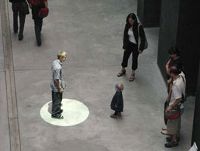
Marie Sester, ACCESS, 2003The institutional embrace
By the early 1990s, New Media art had begun to attract the interest of museums, galleries, funders, and other art institutions, despite widespread skepticism among proponents of more traditional forms, like painting and sculpture. Some cultural institutions, however, were already familiar with computer-based art. In the early 1970s, around the same time that Video art was beginning to gain critical and curatorial support, a handful of exhibitions of computer-based art work appeared in mainstream museums on both sides of the Atlantic. In 1970, the Institute of Contemporary Art (ICA) in London organized “Cybernetic Serendipity,” a show that explored how computer-driven automatons and other technological devices were used in traditional art-making, including poetry, painting, and sculpture. That same year, the exhibition “Software” at the Jewish Museum in New York treated computer programming as a metaphor for conceptual art. A year later, the Los Angeles County Museum of Art (LACMA) featured a show of work produced in LACMA’s Art and Technology program, an initiative that matched contemporary artists like Robert Irwin, Robert Rauschenberg, and Richard Serra with major corporations to realize art projects. This brief curatorial trend came to an end in the mid-1970s as members of the counterculture (many of whom were artists and curators) came to associate technology with corporate capitalism and the Vietnam War.
Art museums then largely ignored digital and electronic art until the early 1990s, shortly before the rise of the New Media art movement. In 1990, Robert Riley, a curator in the Media arts department of the San Francisco Museum of Modern Art (SFMoMA), organized “Bay Area Media,” an exhibition that featured several works of computer-based art. These included Lynn Hershman’s Deep Contact (1990), an interactive installation about seduction and illusion in which viewers navigated through a series of video segments via a touch-sensitive screen, and Jim Campbell’s Hallucination (1988-1990), which merged live video of museum-goers with stored footage of fire. In 1993, Jon Ippolito, an associate curator at the Guggenheim Museum in New York, organized “Virtual Reality: An Emerging Medium,” an introduction to artistic uses of a technology that was the focus of much attention both in the mainstream media and in the Art and Technology world at that time.
In the mid-1990s, support for New Media art broadened as curators responded to the dotcom-era enthusiasm for new media and to the quality and quantity of the work that was being produced. In 1995, the Whitney Museum of American Art became the first museum to acquire a work of Net art: Douglas Davis’ World’s First Collaborative Sentence (1994), a Web site where visitors could add to an endless string of words. Also in 1995, New York’s Dia Center for the Arts launched its Artists’ Web Projects program, which commissioned both established contemporary artists (like Cheryl Donegan, Tony Oursler, and Francis Alÿs) and emerging New Media artists (such as James Buckhouse, Kristin Lucas, and Olia Lialina) to produce works of Net art. In 1996, the Walker Art Center in Minneapolis launched Gallery 9, an ambitious commissioning program and extensive online gallery of New Media art, under the guidance of the influential curator Steve Dietz. In 1997, the international contemporary art exhibition Documenta featured Net art prominently in a separate “Hybrid Workspace” section. In an irreverent act characteristic of early Net art’s anti-art-world attitude, Vuk Cosic appropriated the Documenta Web site, displaying a copy on his own server.
From this point, institutional interest in New Media art expanded significantly. By the late 1990s, other art institutions, including London’s ICA, New York’s New Museum of Contemporary Art, and Paris’s Cartier Foundation, among others, supported the exhibition of New Media art. In January 2000, the Whitney appointed Christiane Paul, who founded the New Media art journal Intelligent Agent, as adjunct curator of digital art, and the same month, SFMoMA appointed Benjamin Weil, co-founder of the Net art Web site äda’Web, as curator of media arts.
Later that year, the Whitney Biennial — considered a barometer of trends in contemporary American art — included nine works of Net art, such as Ken Goldberg’s Ouija 2000 (2000) and Mark Amerika’s Grammatron (1997). The following year, the Whitney staged “Bitstreams,” a museum-wide exhibition of art involving digital processes, including New Media art as well as painting, photography, and sculpture. At the same time, SFMoMA presented a similarly ambitious exhibition: “010101: Art in Technological Times.” That summer, the Slovenian Pavilion at the 49th Venice Biennale featured a work of New Media art, Biennale.py, a computer virus developed by 0100101110101101.ORG in conjunction with the collective epidemiC. Even New York’s Metropolitan Museum of Art began to collect New Media art, acquiring Every Shot, Every Episode by Jennifer and Kevin McCoy in 2002.
Independent initiatives
While many New Media artists sought and received the institutional imprimatur of museum exhibitions, others were indifferent to the art world and its power brokers. This latter group preferred to work outside of the mainstream contemporary art world, instead working within the communities and institutions of the Media art and Art and Technology fields, where their work was more widely understood. Media art had grown out of the Video art movement that started to develop in the mid-1960s, and Art and Technology had been a subject of study since the late 1970s at such academic programs as New York University’s Interactive Telecommunications Program, founded in 1979, and Massachusetts Institute of Technology’s Media Lab, founded in 1985.
Festivals and conferences devoted to Art and Technology had long existed in Europe, thanks mainly to a tradition of generous government support for the arts. The most notable of these are the Ars Electronica festival in Linz, Austria, which was first held in 1979, and the Inter-society for the Electronic Arts (ISEA), which organized its first symposium in 1988. In 1997, the ZKM Center for Art and Media, a major New Media art museum and research institute, opened in Karlsruhe, Germany. Asia, too, was a site for institutional support for Art and Technology: in 1997, for example, the Inter-communication Center, a museum of New Media art, opened in Tokyo, supported by the Japanese telephone company, NTT. Other major corporate supporters of Art and Technology in Japan included Canon and Shiseido, both of which supported art labs in the 1990s.
In the United States, a number of small, not-for-profit organizations sprouted up in New York and other cities, starting in the mid-1990s. Online communities formed by New Media artists, such as artnetweb, Rhizome.org, and The Thing (all headquartered in New York), were established as virtual spaces for the display, discussion, and documentation of New Media art, playing a key role in the international movement’s evolution. Physical spaces for New Media art followed in the late 1990s and early 2000s. These included Eyebeam Atelier and Location One in New York, and Art Interactive in Cambridge, Massachusetts. Smaller New Media art organizations appeared in Europe as well. Notable examples include Internationale Stadt and Micro in Berlin, C3 in Budapest, Ljudmila in Ljubljana, and plugin in Basel.
Fueled by evidence of growing international institutional support, government agencies and private foundations began to fund New Media art in the late 1990s and early 2000s. Leading public supporters of New Media art included the Arts Council in the United Kingdom, the Canada Council for the Arts, the Mondriaan Foundation in the Netherlands, the United States’ National Endowment for the Arts, and the New York State Council on the Arts. Private funders included the Andy Warhol Foundation; Creative Capital; the Daniel Langlois Foundation for Art, Science, and Technology; the Ford Foundation; the Jerome Foundation; and the Rockefeller Foundation. Despite the strength of this support, there remained many arts funders and other established institutions that were not interested in New Media art.
Of course, many artists continued to operate independently, in essence carrying on in the initial, anti-establishment spirit of the New Media art movement. Artists working with emerging technologies often used personal Web sites, e-mail lists, or other forms of media dissemination to establish and maintain an international presence and a global audience without the help of galleries, museums, or other institutions.
Many New Media artists were profoundly skeptical of the art market, the notion of commercializing art, and market economies in general. The formative years of the New Media art movement followed the end of the Cold War, and these artists were critical of capitalism and the victory of free-market ideology symbolized by the dissolution of the Soviet Union. In addition, Left-leaning artists also saw in the Internet an opportunity to realize progressive, anti-capitalist ideals that seemed threatened by the collapse of Communism. In the early years of New Media art, critics, curators, and artists used the term “gift economy” to describe the way in which New Media art was circulated. Rather than selling and buying works of art, members of the New Media art community generally preferred to exchange work for free via Web sites, e-mail lists, alternative spaces, and other venues. This free sharing was similar both in spirit and in practice to the way in which open source software was distributed.
Collecting and preserving New Media art
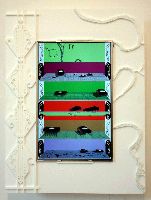
John F. Simon Jr., A-life, 2003
The inherently ephemeral nature of much New Media art, as well as its often unfamiliar aesthetics and technologies, posed a challenge to gallerists and collectors. Some artists provide a CD-ROM or other storage device containing a copy of the work (e.g., the sale of a floppy disk containing The World’s First Collaborative Sentence to collectors in 1995). Others produce works that take the form of physical objects, such as John F. Simon, Jr.’s wall-mounted “art appliances,” ( p. ), which recall framed paintings. Feng Mengbo’s Iris prints from his interactive CD-ROMs (image), and Cory Arcangel’s silk-screens of images from his Game art works (p.), have had commercial success, partly because such forms are familiar and relatively easy to exhibit.
Despite the anti-commercial attitude of many New Media artists and the technological hurdles of presenting their work in galleries, some dealers have sustained significant New Media art programs. Notable examples include Postmasters Gallery, Sandra Gering Gallery, and Bryce Wolkowicz Gallery in New York, Bitforms Gallery in New York and Seoul, and GIMA in Berlin.
Because of its often immaterial nature and its reliance on software and equipment that rapidly becomes obsolete and unavailable, New Media art is particularly difficult to preserve. Just as most of Eva Hesse’s latex sculptures from the 1960s and 70s have deteriorated, many works of New Media art will soon be beyond repair. In 2001, a consortium of museums and arts organizations founded the Variable Media Network. These included the Berkeley Art Museum/Pacific Film Archives in Berkeley; Franklin Furnace, the Guggenheim Museum, and Rhizome.org in New York, the Daniel Langlois Foundation for Art, Science, and Technology in Montreal, the Performance Art Festival + Archives in Cleveland, and the Walker Art Center in Minneapolis. Dedicated to finding ways to preserve works made with non-traditional, ephemeral materials, such as Nam June Paik’s video installations, Felix Gonzalez-Torres’s piles of give-away candies, and Marc Napier’s Net art works, the Network has developed a number of case studies and publications, and a questionnaire that organizations can use to gather preservation-related information from artists. Notable strategies for preserving works of New Media art include documentation (e.g., taking screen shots of Web pages), migration (e.g., replacing outdated HTML tags with current ones), emulation (software that simulates obsolete hardware), and recreation (reproducing old work using new technology).
As of this writing, it remains unclear whether New Media art has run its course as a movement. Artists have always experimented with emerging media, reflecting on and complicating the relationships between culture and technology, and will certainly continue to do so. The explosion of creativity and critical thought that characterized New Media art from the mid-1990s to the early 2000s shows no sign of slowing. But as the boundaries separating New Media art from more traditional forms like painting and sculpture grow less distinct, New Media art will likely be absorbed into the culture at large. Like Dada, Pop, and Conceptual art, it may end as a movement but live on as a tendency?a set of ideas, sensibilities, and methods that appear unpredictably and in multiplicitous forms.
Download the pdf : New Media Art – Introduction – Mark Tribe – Brown University Wiki

